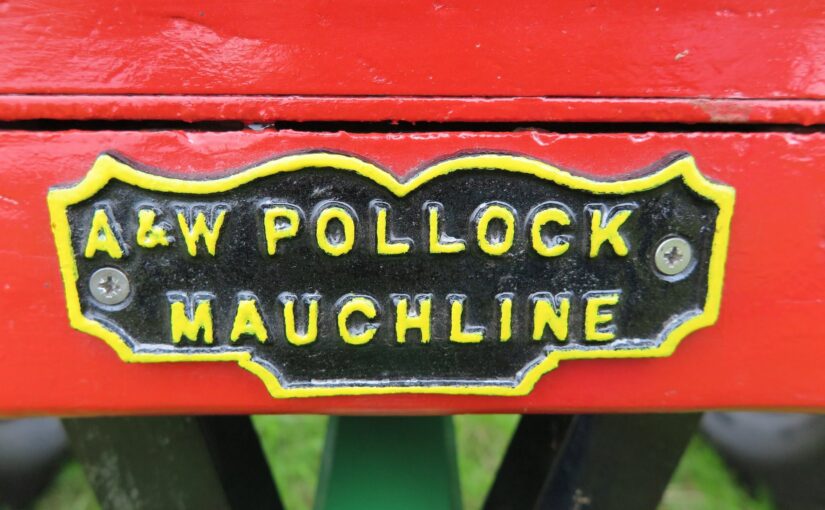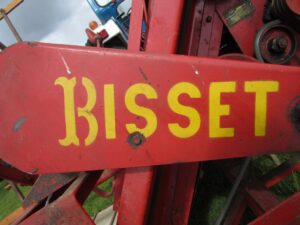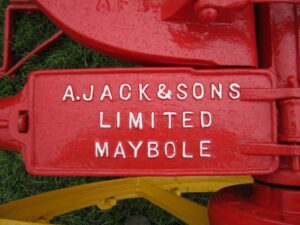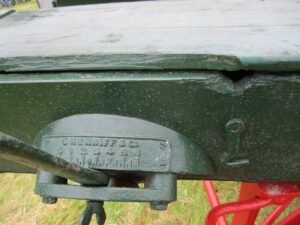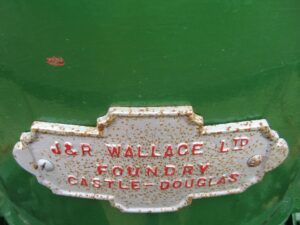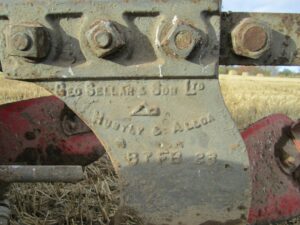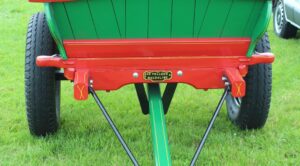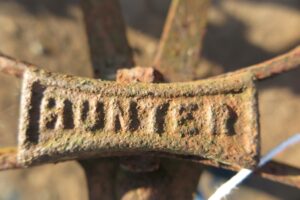The largest shows of the Highland Show of the Royal Highland and Agricultural Society of Scotland were usually those held in the Edinburgh and Glasgow Show Districts. Not only did they attract local exhibitors within the Show District but also ones from much further afield. The largest number of English exhibitors were also found at these two shows.
The Highland Show in 1897 provides a good account of what was new and innovative in one of the large show centres at the end of the nineteenth century. There has been a lot of work to mechanise farming, especially harvesting activities (grain and potato) and steps were being taken to mechanise milking, seen in the competition for a milking machine. There was also a large array of implements and machines available to the agriculturist.
The Scotsman provides an extensive account of the Highland in Glasgow in 1897. It is worth quoting at length to see how it was reported:
“The space set apart for the implement yard exceeds 5000 feet, and there are 2227 implements shown on 183 stands. Although not the largest show of implements that has been seen at Glasgow, it is all over a good exhibition, and embraces everything that embraces everything that enters into farm husbandry. At Perth last year the number of implements shown was 1945, and at Dumfries in 1895 they reached the large number of 2265. This year’s entry has been exceeded at only seven of the seventy shows held by the Society; and it is larger by 600 than that at last Glasgow show in 1888, but is 400 less than at the show of 1882. Although there are no absolute novelties in the implement section, there is no end of variety, and all the productions of the agricultural engineer are shown with their most recent improvements. The Society do not this year offer prizes for implements, but in connection with the show a competitive test of milking machines took place a month or two ago, when the prize of £50 was awarded to Mr William Murchland, Kilmarnock. His machine will be shown in working operation daily, and will be one of the chief attractions of the show. It was seen by the judges at work on three farms, and on each occasion samples of the milk drawn from the cows by the machine, and from the same cows by hand, were taken and set, in order to test the keeping qualities of the milk. On two of the farms the machine had been at work since 1891, and on the third for two months, and the judges stated that in each case it was found to perform the operation of milking efficiently and speedily. The time occupied for each cow was generally from four to six minutes, sometimes rather less. It seemed to cause no discomfort to the cows, and no injury to the teats or udder. It drew the milk by continuous suction, without any apparent pulsating movement. The apparatus was simple in its construction, equally simple in its working, and not difficult to clean or keep clean. The power required to work the machine was not great, At the first farm a half-horsepower oil engine milked ten cows at a time quite easily. Until this engine was put in recently, the machine was worked by one man, with an ordinary force pump. In every instance, the samples of milk drawn by the machine were found to keep satisfactorily. After a lapse of forty-eight hours they were perfectly sweet and in no respect inferior to the milk drawn by hand. The judges state that they regard this machine as a practical success, and are of opinion that in large dairies, where milkers are scarce, it may be introduced with advantage.
The exhibition of implements is the largest that has been seen at the Highland Show for the last twelve years, and in every respect the department is most complete. Every class of machine used in husbandry is on exhibition, and no more striking example of the great progress that has taken place in the economy of the farm could be afforded than the present display of machinery for facilitating the farm work of today. One of the first stands to command attention is that of Messrs George Gray & Co., Uddingston Plough Works, where a very fine assortment of ploughs of all kinds is on view. Next to this stand is that of Messrs John Drummond & Son, engineers, Cumnock, who exhibit two kinds of superior thrashing machines. A large and complete stand is that of Messrs A. Newlands & Sons, Linlithgow, where all kinds of farm machinery are on view. One of the features of this stand is the display of drill ploughs, which baulk up the drills in such a fashion as to leave no green potatoes. A particularly good implement is the potato-lifter, which so works as to lift up the tubers without injuring them. The action of the machine is the same as that of a man lifting potatoes. Its action is very natural. In most machines of this kind the action is rotary, but here the machine only describes a half-circle, with the result that the potatoes are delved out as if by manual labour. The invention, which is patented by Mr Newlands and Mr Burns, a potato merchant, has been in use this year digging out the green potatoes at Girvan. Another exhibit at this stand worthy of mention is a self-acting horse-rake of very simple mechanism. Passing on, the next stand to call for notice is that of Mr William Elder, Berwick upon Tweed, who shows a varied and interesting group of machines. A feature is the improved mower and reaper, worked from the hinge bar instead of from the pole, thus dispensing entirely with side draught. The broadcast sowers of this firm are known all over the country, and are great favourites on many leading farms. Some improvements have been introduced into them this year, and seed box having been made larger, to mention only one improvement. The steel-board ridging ploughs are so constructed that the draught weight is reduced to a minimum.
Great labour-saving implements are the drill rollers and grubbers, which are so notched as to break the clods, and can be adjusted to any size or width of the drill. Mr A. Pollock, Mauchline, shows a very good collection of labour-saving applicances, and it may be mentioned that many of the products of this firm have already been booked, so great is the demand for the machiens of this prominent Ayrshire maker. A very good substantial combined reaper and mower of a new style, with a tilting board for hay and corn, is one of the features of this stand; while a hay and straw press, which is on show, is so arranged that one person can lift it by its own lever on to its wheels in one minute after the men stop baling, making it easy for transport. Practical agriculturists should make a pause at this exhibit. The distinction of having won the gold medal at Haddington belongs to this press. A very handy rick lifter is case-hardened in the centre of the wheel as well as in the axle, thus adding to its durability. This machine only weighs 6cwt gross. A patent hay collector is also on view, as well as an improved potato digger; while there is an example of Nicholson’s patent switchback hay turner, which Mr Pollock was the first to introduce into Ayrshire. There are also shown a double cheese press and a patent curd mill, similar to those used in the Dairy School at Kilmarnock. The features of the curd mill are the round teeth and the open grating in the centre, enabling it to break up more effectively, and without getting twisted round the breaker.
Messrs George Sellar & Son, Huntly, have a goodly show of ploughs, harrows, grubbers, and binders. Messrs P. & R. Fleming & Co., Glasgow, have one of the largest stands in the implement yard. A prominent feature is the corrugate d steel shed fitted with the horse fork. Beneath the shed is a large assortment of dairy and laundry utensils, while a large Bradford windmill is one of the features of the landscape. It is claimed for this windmill that the highest wind will not overcome it, and certainly it has plenty of opportunity of distinguishing its capabilities yesterday. The firm also show many of the machines for which they are the agents. Messrs John Gray & Co., Uddingtson, have on show a large display of ploughs and other agricultural implements; while Mr Charles Weir, Strathaven, exhibits rick lifters and churns. Mr Thomas Turnbull, Castle Bank, Dumfries, has a stand on which he shows an improved Dumfries broadcast sower for grain and grass seeds, along with chaff cutters and grinding and churning mills. Weighing machines have of late been coming to the front in farm work, and the stand of Messrs Ward & Avery, Glasgow, devoted to these exhibits, is therefore all the more interesting. Messrs Henry Pooley & Son, Glasgow, also show in this department a number of weighbridges of various capacities. Mr John Scoular, Stirling, makes a large display of agricultural appliances; and the stand of Mr J. P. Cathcart, Glasgow, is also a most complete one. The machines of Walter A. Wood are exhibited at the stands of Messrs P. & R. Fleming, Glasgow, and George Sellar & Sons, Huntly. Messrs Kemp & Nicholson, Stirling, have a large stand on which they show horse rakes, reapers, mowers, hay collectors, spring carts, farm carts, vans and lorries. The Morgan hay baler at this stand is a machine which can load 50cwt of hay on an ordinary railway wagon, pressing hay to double the density of the old-fashioned press. An improved cart turnip cutting machine is worthy of notice here. Messrs James Grey & Co, Stirling, have also a goodly collection of implements. One of the largest stamds in the show is that of Messrs A. & J. Main & Co., Edinburgh and Glasgow. The chief exhibits at this stand are the Deering binders, an American make of machine which has been pushing its way to the front in Scotland.
The Deering pony binder is fitted with roller and ball bearings while the Deering ideal mowers and combined mowers and reapers are also fitted in a similar fashion. The Deering Harvester Company introduced ball bearings into their machines five years ago, and since that time many other firms have adopted this contrivance. One of their pony binders is fitted with slot conveyors instead of canvasses. Their McDonald turnip topping and tailing machine won a silver medal at the Dumfries Highland Show. Shown for the first time was the one horse back-delivery reaper and mower, which is specially adapted for small farms and crofts, and which is used as a supplementary machine to the binder for opening up fields. With Brown’s Cammo cart turnip cutting machine, also exhibited at this stand, a cartful of turnips can be cut in seven minutes. Messrs Thomas Hunter & Sons, Maybole, show a very nice collection of implements of general utility in the cultivation of the soil, chiefly applicable to the root crops. Mr Wm McNaughton, Stirling, shows hand presses. Messrs J. D. Allan & Sons, Dunkeld; Mr William Dickie, East Kilbride; Mr Matthew Dunlop, Glasgow, and Messrs John Turnbull & Sons, Dunmore, Larbert, have all good collections of various kinds of agricultural implements. Messrs G. McCartney & Co., Old Cumnock, exhibit a couple of thrashing mills- one of them a high speed machine fitted with riddle and fanners. An attractive display is made by Messrs Thomas Sherriff & Co., Westbarns, Dunbar. A feature of their exhibition is an improved broadcast sowing machine for grain and grass seeds, which at Haddington Show on Saturday was awarded a silver medal. This comprehensive stand also includes a collapsible sheep fodder rack of novel design.
Messrs John Wallace & Sons, Glasgow, like many other local firms, have a large display, comprising the City of Glasgow and the Thistle binders, the popular Massey-Harris cultivators, and the Champion potato-digger, with two and three horse trees. The hay “tedders’ exhibited by the firm are worth the attention of visitors. Driven by one horse, they are every day coming into greater demand. Naturally a prominent machine on the stand of Messrs J. Bisset & Sons, Blairgowrie, is the firm’s open back binder, which was shown at the trials in connection with the show at Edinburgh in 893, and obtained a favourable notice from the judges then. Among the firm’s other exhibits is the safety potato digger. Messrs Alexander Jack & Sons, Maybole, have a large stand, on which are specimens of the strong and compact Empire binder and the well-known Caledonia potato digger, which, being fitted with enclosed gearing, is capable of standing a great deal of wear and tear. The digger, which was first at the trials of the Leicester Royal Show a year ago, holds a prominent position in the market as a perfectly arranged machine. A moderately priced horse hoe and specimens of the Dux Canadian ploughs are among the other exhibits by which the firm is represented.
The motion yard is not very extensive, but it is extremely interesting, and embraces an excellent collection of machinery of the farm. Mr H. B. Fleming, Kirkliston, shows the “Bisset” reaper and binder. Messrs Carrick & Ritchie, Edinburgh, show a large collection of their improved turbines, pelton wheels, jet water motors, and other appliances for the utilisation of water for power for mills, farm machinery &c. the application of water power to country house lighting by electricity is illustrated by a combined turbine and dynamo. Another novelty is a combined jet water motor and dynamo suitable for lighting a small house containing thirty lamps. Another application of water power for the ventilation of buildings is shown. This is a very compact combination of a jet motor and ventilating fan, by which the town water supply entering a cistern may be made to yield up its power in driving the ventilating fan, and then pass into the cistern for domestic use. Messrs Ben Reid & Co., Aberdeen, have an attractive stand, at which the show in notion five thrashing machines of the newest and most improved type, fitted with double blast and barley awner. They have also at work one of the Massey Harris Brantford binders, fitted with the original patent slat conveyer. They likewise show their well-known broadcast sowing machines and manure distributers, together with a varied assortment of useful articles for farm work. Thrashing machiens and engines are the leading features of the stand occupied by Mr R. G. Morton, Errol, and these are of an excellent description, neatly designed, and well finished. Windmills are conspicuous objects on the stands of Messrs P. & W. Maclellan, Glasgow, and Messrs John S. Millar & Son, Annan. As in former years, Messrs Thos Gibson & Son, Fountainbridge, Edinburgh, have one of the largest individual spaces in the yard allotted to their exhibits. Their name is so well known for ornamental iron work that little need be said on their behalf. Mr William Sinton, Jedburgh, shows an interesting assortment of churns; and Mr John Gray, Stranraer, has on view cheese vats, presses, refrigerators, and other dairy utensils. The Dairy Supply Company, Edinburgh, exhibit a large collection of separators and other appliances of a useful character. The Sorn Dairy Supply, Glasgow, have a working dairy, which should prove a source of much attraction, the process of buttermaking being carried on daily. Messrs Watson, Laidlaw, & Co., Glasgow, show a number of cream separators in this section of the implement yard.”
Quite a show! Lots to see for the framer and agriculturist.
